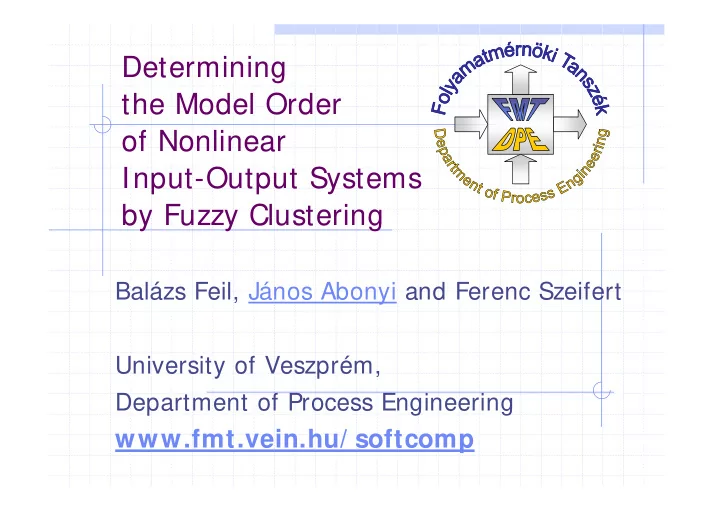

Determining the Model Order of Nonlinear Input-Output Systems by Fuzzy Clustering Balázs Feil, János Abonyi and Ferenc Szeifert University of Veszprém, Department of Process Engineering www.fmt.vein.hu/ softcomp
2/10 Overview Determining the model order of dynamical systems Introduction to False Nearest Neighbors algorithm (FNN) Fuzzy clustering The proposed approach Illustrative results Summary
3/10 Model Order Selection ? = − τ − τ − τ y ( t ) G [ y ( t ), y ( t 2 ),..., y ( t l ), [ ] − τ − τ = ψ u ( t ),..., u ( t m )] G ( t ) l , m ? u y System
4/10 The basic idea of FNN Geometrical view 3 variables Finds the nearest neighbors of all data Calculates the ratio of the bad neighbors Critical step: what are 2 variables the bad neighbors? 1 variable
5/10 The FNN algorithm = ψ − ψ D ( k ) ( j ) Find the nearest neighbor Find the nearest neighbor l , m l , m 2 min j form all data form all data − ( ) ( ) y k y j what is the relative distance what is the relative distance ≤ R ψ − ψ of the related outputs of the related outputs ( k ) ( j ) , , l m l m 2 New data New data How can we Calculate the ratio of Calculate the ratio of define R to the bad neighbors bad neighbors the get good Increase the Increase the results? dimension dimension
Cluster based determination of R 6/10 Gath-Geva clustering Cluster prototype (center, covariance matrix) Extraction of the parameters of local linear models y x
The proposed algorithm 7/10 Identification data in the increased dimensional space Identification data in the increased dimensional space Selected data and its Selected data and its Clustering Clustering nearest neighbor nearest neighbor New data New data R R Cluster analysis Cluster analysis − y ( k ) y ( j ) ≤ R Bad or good neighbors Bad or good neighbors ψ − ψ ( k ) ( j ) Check the dimension Check the dimension , , l m l m 2 based on the shape based on the shape of the clusters of the clusters Calculation of the ratio Calculation of the ratio of the bad neighbors of the bad neighbors Increase the dimension Increase the dimension
Results I. 8/10 = − − − + − + − + − y ( k ) 1 . 5 y ( k 1 ) 0 . 75 y ( k 2 ) 0 . 125 y ( k 3 ) u ( k 1 ) u ( k 2 ) ! ! ! !
9/10 Results II. ! ! ! ! ! ! ! ! 100 5 80 4 60 FNN (% ) 3 E IG 40 2 20 1 0 0 0 0 1 0 1 0 1 2 1 2 2 3 2 3 3 3 4 4 4 Kimeneti rang 4 Bemeneti rang Kimeneti rang Bemeneti rang
10/10 Conclusions The efficiency of the original FNN algorithm has been increased The idea is based on the geometrical view of the clusters The threshold value is calculated based on the shape of the clusters
Recommend
More recommend